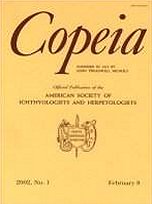Life-history aspects of Noturus phaeus, the Brown Madtom, were studied from August 1993 to July 1994 using samples collected from Bay Springs Branch (Little Tallahatchie River drainage), Mississippi. Noturus phaeus exhibited nocturnal feeding with a diet composed primarily of dipteran larvae, trichopteran larvae, and decapods (crayfish). Annuli from otoliths were successfully used to assist in age-class identification. It was common for individuals of both sexes to reach age-3, whereas some males were age-4 or older. Brown madtoms used woody debris and undercut banks as their primary daytime microhabitat, and stream flow (complex, run, pool) was the best predictor of the presence/absence of madtoms, being most often found in areas of complex (varying) flow. Abundance (density) was similar to those of other species, and N. phaeus was not collected in areas without either debris, aquatic vegetation, or undercut banks.
How to translate text using browser tools
1 August 2000
Aspects of Brown Madtom, Noturus phaeus, Life History in Northern Mississippi
Matthew D. Chan,
Glenn R. Parsons
ACCESS THE FULL ARTICLE





